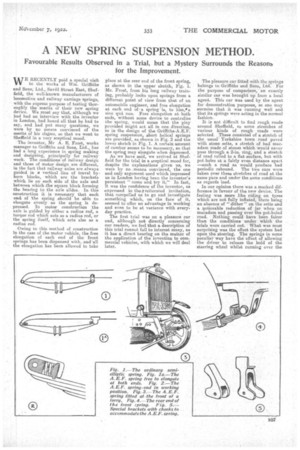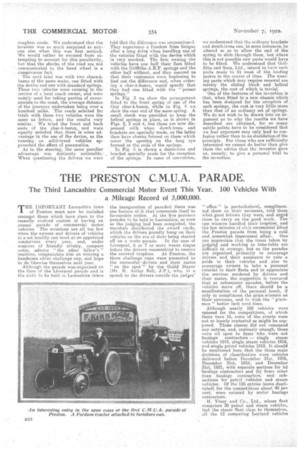A NEW SPRING SUSPENSION METHOD.
Page 11

Page 12

If you've noticed an error in this article please click here to report it so we can fix it.
Favourable Results Observed in a Trial, but a Mystery Surrounds the Reasons for the Improvement.
WE RECENTLY paid a special visit to the works of Wm. Griffiths and Sons, Ltd., Savill Street Rsqt, Sheffield, the well-known manufacturers of locomotive and railway carriage springs, with the express purpose of testing thoroughly the merits of their new spring device. We must say that, although we had had an interview with the inventor in London, had heard all that he had to say, and had put many questions, we were by no means convinced of the merits of his cligms, so that we went to Sheffield in a very sceptical mood.
The inventor, Mr A. E. Frost, works manager to Griffiths and Sons, Ltd., has had a long experience in spring making and designing, principally for railway work. The conditions of railway design and those of motor design are different, in the fact that railway axles are always
guided in vertical line of travel Syhorn blocks, which are the brackets which lie on each side of the axle and between which The square block forming the bearing to the axle slides. In, this construction it is necessary that each end, of 'the spring should be akile to elongate evenly as the spring is depressed. In motor construction the axle is guided by either a radius rod, a torque rod which acts as a radius rod, or the spring itself, which acts also as a radius rod.
Owing to this method of construction in the case of the motor vehicle, the free elongation of each end of the front springs has been dispensed with, .and'all the elongation has bean allowed to take
place at the rear end of the front spring, as shown in the upper sketch, Fig. 1. Mr. Frost, from his long railway training, probably looks upon springs from a different point of view from that of an automobile engineer, and free elongation at each end of a spring is, to him,•a, sine qua non. Free elongation at both ends, without some device to centralize the spring, would mean that the play provided might act all in one direction, so in the design of the Griffiths-A.E.F. spring suspension, short helical springs are provided, as shown in Fig. 2 and the lower sketch in Fig. 1. A certain amount of camber seems to he necessary, so that the spring may elongate when depressed.
As we have said, we arrived at Sheffield for the trial in a sceptical mood for, despite the explanations given us, we were by no .means convinced, the one and only argument used which impressed us in London having been the inventor's persistent " come and try it." In fact, it was the confidence of the inventor, as expressed in the reiterated invitation, that compelled us to go and investigate something which, on the face of it, seemed to'effer no advantage in working and even to be at variance with everyday practice.
The first trial was on a pleasure car and, although not directly concerning our readers, we feel that a description of this trial cannot fail to interest many, as it has a direct bearing on the matter of the application of the invention to commercial vehicles, with which we will deal later.
The pleasure car fitted with the springs belongs to Griffiths and Sons, Ltd. For the purpose of comparison, an exactly similar car was brought up from a local agent. This car was used by the agent for demonstration purposes, so one may surmise that it was running well and that its springs were acting in the normal fashion,
It is not difficult to find rough roads around Sheffield, so some stretches of various kinds of rough roads were selected. These consisted of a stretch of the usual Yorkshire town road paved with stone setts, a stretch of bad macadam made of stones which would never pass through a 2-in, ring, and a stretch of road rolled to a flat surface, bat with pot holes at a fairly even distance apart —such a road as would produce bad periodic rebound. The two cars were taken over these stretches of road at the same pace and under the same conditions as regards load.
In our opinion there was a marked difference in favour of the new device. The feeling was more like riding on tyres which are not fully inflated, there being an absence of " dither " on the setts and a noticeable reduction of jar when on macadam and passing over the pot-holed road. Nothing could have been fairer than the conditions under which the trials were carried out. What was most surprising was the effect the system had Upon the steering. The springs in some peculiar way have the effect of allowing the driver to release the hold of the steering wheel whilst running over the
roughest roads. We understand that the inventor was as much surprised as anyone else when this was first noticed. We would rather be excused from attempting to account for this peculiarity, but that the shocks of the road are not communicated to the hand wheel is a conspicuous fact.
The next trial was with two ehars-hbanes of the same make, one fitted with the device and one with standard springs. These two vehicles were running in the service of a local coach owner, and were mostly used for taking parties of excursionists to the coast, the average distance of the journeys undertaken being over a hundred miles. The roads . selected for trials with these two vehicles were the same as before, and the results very similar. We tried the front and back seats of the ehar-h-banes, and were equally satisfied that there is some advantage in the use of the device, as the running on solid-tyred vehicles ap• proached the effect of pneumatics.
As to the steering, the same peculiar advantage was distinctly noticeable.When questioning the drivees we were told that the clifferenee was unquestioned. They experience a freedom from fatigue after a long drive when handling one of the vehicles fitted with the device which 15 very marked. The firm owning the vehicles have one half their fleet fitted with the Ciriffiths•A.E.F. springs and the other half without, and they assured us that their customers were beginning to find out the difference and, when ordering a char-h-banes, would specify that they had one fitted with the " patent springs.'' In Fig. 3 we show the arrangement fitted to the front spring of one of the Guy char-I-banes, while in Fig. 4 we show the rear end of the sa,nie spring. A sinall cheek WAS provided to keep the helical springs in place, as is shown in Figs. 2, 3 and 4, but these are-now dispensed with when dumb-irons and brackets are specially made, as the latter then have cheeks formed on them which cover the opening on the long eye formed at the ends of the springs,
In Fig 5 is shown a dumb-iron and bracket specially made for the reception of the springs. In cases of conversion,
we understand that the ordinary brackets and dumb-irons can, in some instances, be altered so. as to allow the end of the spring to slide through them, but where this is not possible new parts would have to be fitted. We understand that Griffiths and Sons, Ltd., intend to have such parts made to fit most of the leading makes in the course of time. rhe wearing parts which may require renewal are merely the sliding block and helical springs, the cost of which is trivial.
One of the features of the invention is that, when fitted to a new chassis which has been designed for the receptien of such springs, the cost is very little more than that of an ordinary set of springs. We do not wish to be drawn into an argument as to why the results we have described are obtained, for so many subtle points have to lie considered that we fear argument may only lead to confusion rather than to an elucidation of the principle. For those who are sufficiently interested we cannot do better than give them the advice that the inventor gave us, namely, to give a personal trial to the invention.
































